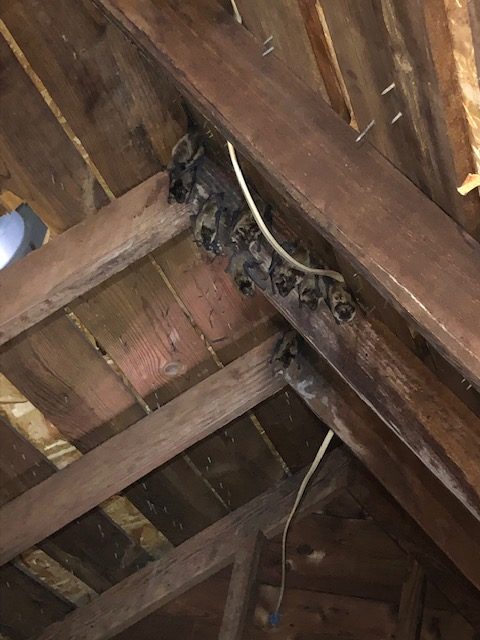There are eleven species of bats commonly found in Ohio. The solitary species are the hoary bat, the silver-haired bat, and the Eastern red bat. Colonial bats tend to roost together and include the little brown bat, the big brown bat, the Northern long-eared bat, and the Indiana bat.
The big brown bat and the little brown bat are the species most likely to roost in people’s Northeast Ohio homes.
Where do bats live in Northeast Ohio?
Typical places bats live are in caves tree hollows, and cracks in large rocks. Bats also use man-made structures like abandoned mines, under bridges, and inside attics or sheds.
Bats roost in need two different locations to live — one in the winter and one in the summer.
During the winter, bats either migrate or hibernate. Bats start hibernating when the temperature drops below 35-40° F. They typically hibernate from October until April in Ohio.
Bats mate in the fall but give birth the following summer. Female bats need to find a safe place to give birth and protect the pups. For the first few months, baby bats cannot fly. So if there is a maternity colony in your attic, you cannot exclude bats from May to August. You will seal the flightless bat pups in your attic; they will die.
What attracts bats to your house?
In both winter and summer, bats are looking for a safe place to roost during the day. Bats have specific temperature and humidity needs, and attics usually provide an ideal location.
Bat removal in the winter
Recently a Cleveland homeowner found evidence of bats in their attic. While returning their Christmas decorations, they found small, elongated pellets. Initially, they worried about a potential rat problem.
After our inspection, we found a colony of hibernating bats in their attic! Because it is still too cold, we could not evict the bats in January. We identified all the potential entry points. Bats can squeeze through a 3/8″ gap. Typical entry points are around the roof in the soffits and fascia board. Roof vents, gable vents, and ridge vents are easy to access for bats.
After identifying all the entry points, we sealed them all but one. In April when the temperature is consisting warmer, we will install a bat valve. The one-way valve allows bats to leave your attic but prevents their reentry.

Bat removal in the summer
As a reminder, it is illegal to kill or exterminate bats in Ohio. The best way to get rid of bats is with an exclusion. During the summer, we do not perform an exclusion when flightless pups are present. It is unlawful to install bat exclusion devices between May 16-July 31 if there are 15 or more bats inside a structure.
Are bats safe to have around the house?
Bats provide a lot of benefits around your property. All bats in Ohio are insectivores. A single bat can consume over 1,000 mosquitoes in one night. Bats are a natural pesticide for crops.
A bat colony in your home should not be ignored. Bats can introduce two you and your family to diseases. Histoplasmosis is a respiratory disorder from a fungus that grows in bat guano. Disturbing a pile of bat poop in your attic can release the spores.
Bat-strain rabies has been recorded in every county in Ohio. According to the CDC, bats are the leading cause of rabies deaths in people in the United States, but fewer than 4% of bats in Ohio have rabies. If you have bats in your attic, avoid them until a professional can solve the problem.


